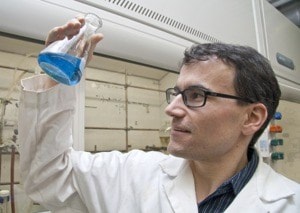Mark MacLachlan remembers the first experiment that set him on a path to his current career, supramolecular chemist.
“It was in Mrs. Murray’s Grade 3 class at Red Bluff elementary school,” he said.
“It was mystery powders. We had to figure out what they were.”
He remembers using a magnifying glass, testing the substances’ solubility in water and tasting (including plaster of Paris.)
“It was my first taste of chemistry and that simple school room experience led to iridescent glass film research and the Steacie Memorial Fellowship.”
MacLachlan was awarded the $250,000 fellowship in late 2011 and will spend the next two years advancing his research of the iridescent glass film project.
After completing elementary and secondary school in Quesnel, he headed for UBC’s first year sciences program.
“I always loved science and math right from elementary school and always did well,” MacLachlan said.
He admitted when he first entered university he was open to all fields including the potential to become a doctor or a dentist, however in his second year MacLachlan soon realized he was most interested in chemistry.
“I felt I had more talents in chemistry by that time,” he said.
“You begin to discover the amazing world of understanding matter and creating new substances.”
He explained chemistry is a lot like cooking.
“We learn about the ingredients and how they combine to create new dishes for the scientific menu.”
After completing his bachelor of science degree in 1995, MacLachlan began working on his Ph.D. at University of Toronto in materials chemistry.
“Materials chemistry can be any number of tangible things, however I was working on new magnetic materials, specifically new magnetic plastics for my Ph.D.”
He found his passion in materials chemistry with the idea of making things no one else has ever created before.
“I knew I wanted to be a researcher once I completed my Ph.D.”
Similar to a medical internship, MacLachlan went on to complete his two-year post-doctorate at Massachusetts Institute of Technology (MIT) in organic materials.
With several applications sent out, he accepted an assistant professorship in organic chemistry back at his alma mater, UBC where he did some lecturing and lots of research.
He achieved tenure in 2007 (based on an evaluation on productivity and achievements) and full professorship in 2011. He was still lecturing some but the bulk of his time was spent on research.
(For all the Big Bang Theory fans, MacLachlan, who loves the wildly popular TV show, said those characters have similar jobs to his and yes, he admits he’s met people similar to those characters, even Sheldon.)
For the past three years, MacLachlan’s research group, which includes undergrads, graduate students and post-doctoral students have worked on many, many chemistry projects, most running concurrently, however, the iridescent glass film discovery was actually an accidental discovery.
“When you look at a butterfly or the shell of a beetle, they reflect light because they’re iridescent,” he explained.
“The reason they reflect is because of the supramolecular structures.
“It was during a forestry research project on pulp where we were looking at nano crystalline cellulose with its rod shapes (which organize into helix-like structures) we discovered we could re-create this structure in glass.”
Iridescent glass film has potential applications for coatings for glasses or windows that block ultraviolet light or reduce heating and air conditioning requirements.
And so with the accidental discovery and subsequent ongoing research, MacLachlan name was put forward by the UBC chemistry department for initially an internal review where six scientists are chosen to be forwarded for possible selection of the Natural Sciences and Engineering Research Council of Canada’s Steacie Memorial Fellowship.
The fellowship recognizes some of the nation’s most promising scientific talent and honours excellence in young scientists (those within 12 years of receiving their doctorate.)
“I figured I didn’t have a chance,” MacLachlan said.
“I was surprised my nomination made it out of the UBC internal competition.”
However, a phone call, just three days before Christmas 2011, informed MacLachlan he had been chosen to receive one of the Steacie fellowships.
“I was shocked. This is a career-changing award,” he said with a big smile.
“For the next two years I will concentrate on the iridescent glass film project.”
The fellowship provides money, time and prestige (its the highest award a young scientist can receive in Canada.)
Despite his resemblance to Leonard Hofstadter of Big Bang Theory fame, at 38, MacLachlan feels his career is on track and his personal life is great. He’s married to an organic chemist and together they have two children.
When asked if he’s kept up with his graduating classmates from the Correlieu class of 1991, MacLachlan said yes, in particular with one fellow graduate, Paul Cyr, who also works at UBC in the technology transfer department and also has his Ph.D. in organic chemistry.
In looking back over his formative school years in Quesnel, MacLachlan ponders those who have made a difference in his life.
“I credit one teacher who inspired me, although there were many wonderful teachers through the years, I’d have to say my high school English teacher,” he said.
“Mr. DeVries made us think and be creative. People don’t see science as creative but that’s the essence of science, nothing is discovered
until scientists get creative.
And, surprisingly, as a scientist I spend 80 – 90 per cent of my time reading and writing.”
